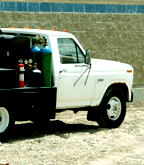
|
 |
Materials Handling: Vehicular Activities
 Electrical contractors often use vans or trucks to transport tools and supplies.
Employees may have to reach over or climb into the small, awkward areas of these automobiles. Electrical contractors often use vans or trucks to transport tools and supplies.
Employees may have to reach over or climb into the small, awkward areas of these automobiles.
Contractors can implement the following solutions to ease the tasks of transporting and retrieving supplies and tools from automobiles.
|
 |
 |
| Reaching into a Vehicle |
Potential Hazards:

|
Figure 1
Employee crouching in a
cluttered van.
|
Crouching or kneeling to reach into the back of a van (Figure 1) or a truck with a shell might put contact stress on the knees and stress on the lower back.
- Employers often use vans with a narrow, short access space to store
materials. Stooping and reaching may be required to access these materials.
Possible Solutions:

|
Figure 2
Roll-out truck bed deck.
|
Perform lifting tasks from a kneeling position and pushing and
pulling tasks from a crouched position when working in cramped areas.
- Install a roll-out truck bed deck (Figure 2). Materials will be free from the confines of the truck shell and sides, allowing
employees to gain easy access to the contents of the truck. These deck platforms also provide a convenient waist-high work space.
- Place the most commonly-used materials closest to doors or in
outside truck bins, minimizing the stooping and reaching.
|
| Loading and Unloading |
Potential Hazards:

|
Figure 3
Employee lifting heavy equipment.
|
Lifting and lowering materials and equipment from the back of
vehicles may place strain on the back.
- Lifting toolboxes, supplies, or other materials over the sides of the
truck stresses the shoulders and back.
Possible Solutions:

|
Figure 4
Hydraulic lift raising
a mobile tool box.
|
Use a vehicle with hydraulic lift equipment (Figure 4).
- Use reach forklifts that
extend the forks over the truck sides and lift materials out of the back.
- Use truck ramps that allow
employees to wheel loads in and out of the back of vehicles.
- Do not lift over the sides of a truck or latched tailgate. Reposition
materials closer to the tailgate so you can lift in the power zone.
- Use a multiple-man lift when necessary. The rule of thumb is one person
for every 50 pounds.
|
|
 |
|

